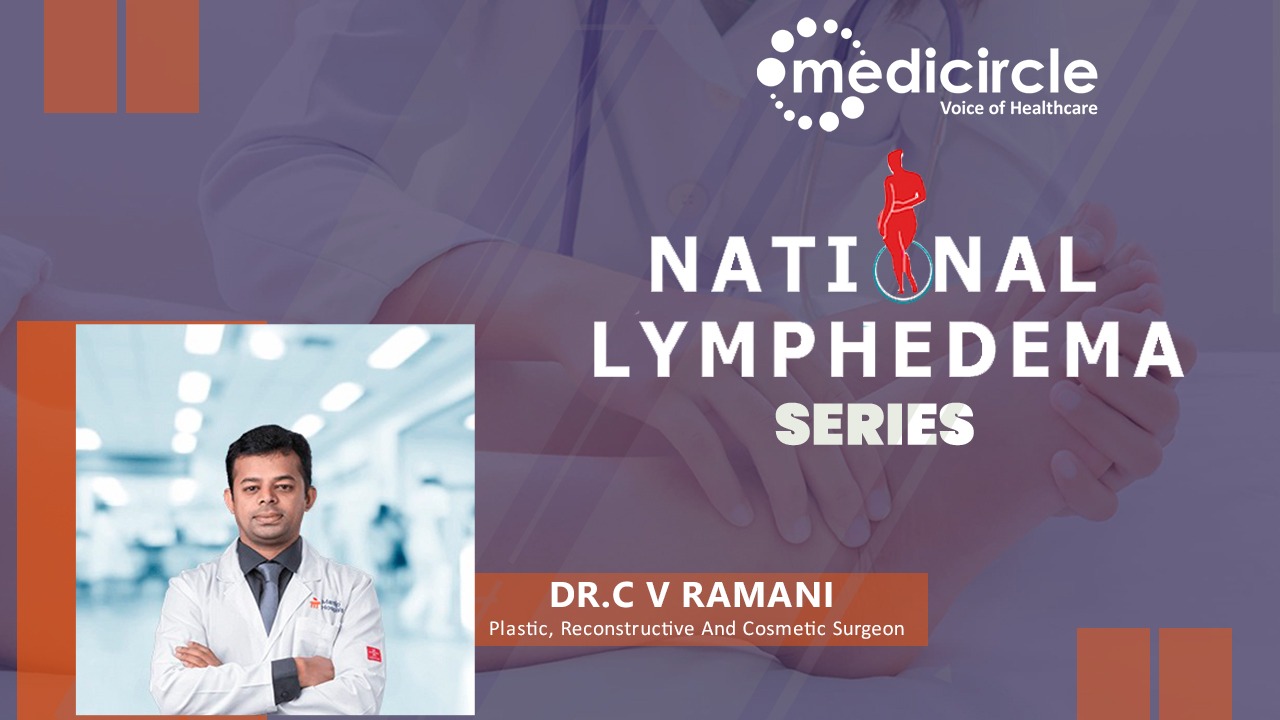Lymphedema refers to swelling that generally occurs in the arms or legs caused by a blockage in the lymphatic system. Despite recent medical advancements that address lymphedema, knowledge about this condition is still lacking among the general population. World Lymphedema Day is a patient-driven initiative to make the cure for lymphedema and lymph-related illnesses, a global health priority. Medicircle is conducting an exclusive Lymphedema Awareness Series featuring eminent vascular surgeons, physiotherapists, and plastic surgeons treating lymphedema to help raise awareness that would help patients to lead their best lives with lymphedema.
Dr. Ramani CV is a Plastic and Reconstructive Surgeon and has experience of 11 years in the field. After his MBBS followed by MS in General Surgery, he also completed M.Ch in Plastic and Reconstructive Surgery. He has gained rich experience in his field of specialization. His field of interest lies in Microsurgery and Lymphedema Management. He has attended various national and international conferences and is an active member of the Indian Society of Reconstructive Microsurgery and Association of Plastic Surgeons of India.
Lymphedema Awareness is Vital
Dr. Ramani mentions, “The initiative taken by Medicircle is a commendable one because awareness is the key in managing lymphedema. Lymphedema is a slowly progressive disease, wherein there is a collection of fluid in the extremities that are the upper limb or the lower limb or even in the abdomen that leads to a progressive swelling and other deformities. So, the early the treatment begins the better it is for the patients.”
Causes of Lymphedema
Dr. Ramani informs, “Causes for lymphedema have been classified into two categories.” He lists down the following causes:
Primary lymphedema – This gets caused by developmental defects which can manifest at the time of birth and it is called congenital lymphedema or it can manifest at the time of puberty up to late 30s and 40s. So, this subset is known as primary lymphedema wherein it is the number of lymph nodes which are abnormally present in the patient.
Secondary lymphedema – It is caused by identifiable reasons like suppose there is surgery of the breast with the removal of the lymph nodes from the armpit. That is going to cause lymphedema in the upper limb. And similarly, if a patient who is having cancer in the cervix and if the lymph nodes are removed from there, the patient is going to develop lymphedema. Filariasis is one of the most common infections which can cause drastic lymphedema,” explains Dr. Ramani.
Role of Surgery in Lymphedema
Dr. Ramani emphasizes, “Nowadays the awareness among the general public as well as the other treating physicians has increased. Lymphedema is always a multi-modality treatment and surgery is an important part of it. It also involves medical management and a team of physiotherapists apart from surgery.
1. So, in the early stage, most plastic surgeons investigate the patient's condition, find out what is the cause for lymphedema, and then use treatment methods by which lymphatic blocks are diverted into the venous system. This involves microsurgery procedures, and this is called lymphatic venous anastomosis.
2. Even if the patient comes at a later stage, we transfer the lymph node from another part of the body. Suppose a patient develops lymphedema of the lower limb. Then we can always take lymph nodes from the neck, upper limb, or from the abdomen without damaging that part and transplant it to the lower limb that acts as a pump and it just sucks out all the lymphatic fluid. So, this is another form of treatment.
3. If the patient lands up in a very late stage wherein there are secondary skin changes like in patients suffering from filariasis from the last 10 years to 15 years. In such cases, it is not reversible because there is always an amount of permanent damage. So, the damaged skin is removed and then restored by way of a skin graft.
There is no cure as such, but you can always improve the patient's physical condition and also improve their psychosocial well-being. So early-stage diagnosis is very important in this,” informs Dr. Ramani.
Obesity Control is Helpful
Dr. Ramani mentions, “There is no proven definitive role of diet in the treatment of Lymphedema but for a patient with the peripheral lymphedema for an upper limb or a lower limb, it is advisable to maintain calorie intake and have a low salt diet. Those having lymph accumulation in the abdomen should take a low amount of long-chain fatty acids and include more short and medium-chain fatty acids, which is more important because there will be a loss of long-chain fatty protein into the abdomen and then you need to replenish their albumin level as well. So, on the whole they need to control their obesity or fat intake to manage different types of lymphedema” says Dr, Ramani.
(Edited by Amrita Priya)

 Dr. Ramani C V, Plastic and Reconstructive Surgeon talks about lymphedema, its causes, the role of surgery, diet control, and how awareness is the key.
Dr. Ramani C V, Plastic and Reconstructive Surgeon talks about lymphedema, its causes, the role of surgery, diet control, and how awareness is the key.









.jpeg)



.jpg)






.jpeg)

.jpg)




.jpg)




.png)

